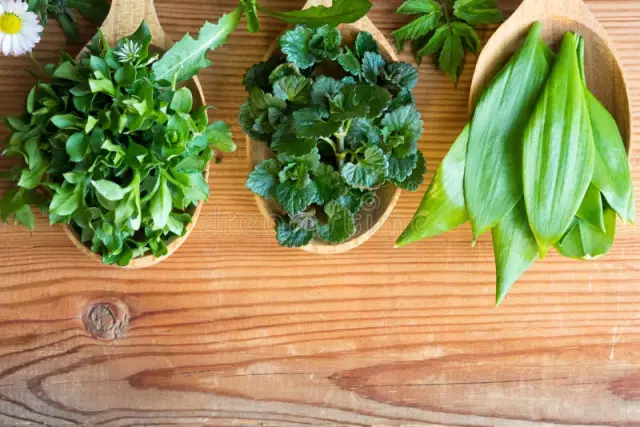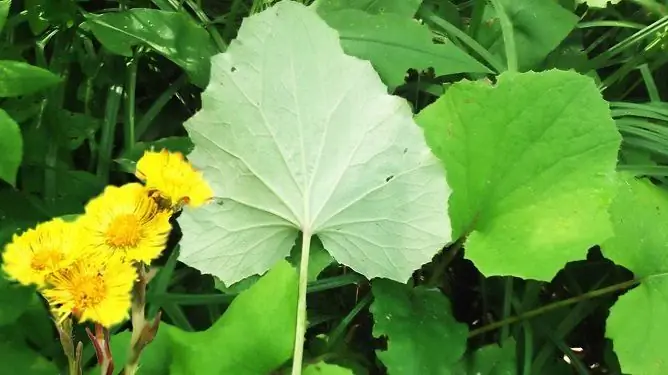- Author Rachel Wainwright [email protected].
- Public 2023-12-15 07:39.
- Last modified 2025-11-02 20:14.
8 edible spring herbs
Spring has come - the season for the awakening of nature. Since ancient times, people have tried to supplement their spring menu with fresh plant foods. Today, most Russians can consume it all year round, but greenhouse plants, as a rule, do not bear comparison with greens of soil origin.
While waiting for the first vegetables from our garden to appear, we can take advantage of the experience of our ancestors and include edible wild herbs in our daily diet.
Nettle
The first spring nettle has thin, delicate and practically not burning leaves. They are widely used in cooking. From young greens you can cook:
- fresh salad;
- omelet;
- soups (lean and meat);
- filling for pies or dumplings;
- cereal meatballs and pancakes (the most delicious are with oatmeal or millet groats);
- green butter;
- curd mass.
Experienced housewives harvest young nettle leaves for future use: dried, salted, fermented and frozen. Juice is squeezed out of fresh raw materials, which can also be preserved.
Nettle is rich in biologically active components that have a beneficial effect on metabolism. Eating it in food helps to remove toxins from the body, increase immunity and general tone.
Fans of young nettle dishes should be aware that some of the substances that make up its composition increase the viscosity of the blood. The plant should not be included in the diet for people suffering from thrombosis, varicose veins, as well as pathologies of the heart and blood vessels. In addition, expectant mothers should not eat nettle, as it can increase the tone of the uterus and provoke premature birth.

Source: depositphotos.com
Bracken
It is one of the most common edible fern species. In the middle lane, it grows everywhere, preferring woodlands. They eat young shoots that appear on the surface of the earth in early May. For the indigenous peoples of the Far East, Eastern Siberia, Japan and Korea, bracken dishes are traditional.
A young sprout of a fern looks like a small roll. It contains a lot of useful substances; it is almost not bitter, in contrast to fully expanded leaves. The collected raw materials must be subjected to immediate culinary processing: during storage, "rolls" quickly harden and lose their nutritional properties.
Bracken leaves can be stored salted, pickled or frozen (in the latter case, they are pre-boiled in salted water). Such semi-finished products are included in various salads, stewed in sour cream, fried in batter. Bracken baked goods are extremely popular in Japan and Korea.
Fern is rich in complete protein and carbohydrates with a minimal fat content. It is considered one of the most useful dietary products that has a beneficial effect on metabolism. Research by Japanese scientists has shown that regular use of salted shoots in food helps to cleanse the body of radionuclides.
Dishes with bracken should not be consumed by pregnant women, lactating women and preschool children, since all parts of the plant contain a small amount of toxic substances. Adults can include this delicacy in their menu in reasonable moderation.

Source: depositphotos.com
Dandelion
Young dandelion leaves are a valuable food product rich in vitamins, iron, manganese, phosphorus and potassium compounds. Dandelion is used to make delicious salads and soups. It is best to use fresh herbs, soaking them in salted water to remove the bitterness. The leaves are especially beneficial for people with iron deficiency anemia and other metabolic disorders. In many European countries, they are widely used to prepare dietary meals that help to lose weight. In addition, dandelion leaves are salted and fermented for future use.
At the beginning of flowering, dandelion buds are harvested. A delicious marinade is prepared from them, which is then added to salads and vinaigrette. Blooming flowers are used to make jam, dandelion "honey" and a pleasant golden wine.
In early spring, at the very beginning of leaf growth, you can dig up last year's dandelion roots. They contain a large amount of inulin and other beneficial substances. The dried, roasted, and ground root is used to make a delicious coffee-like beverage.
Dishes made from dandelion leaves are not recommended for use with pathologies of the liver, biliary tract, as well as with gastritis and stomach ulcer. But the "coffee" drink from the roots of the plant is considered an excellent remedy for these ailments. In addition, it is useful for nursing mothers, as it enhances lactation.

Source: depositphotos.com
Primula ram
This delicate plant has many names: evening primrose, medicinal primrose, ram. In the middle lane, it blooms one of the first. Primrose has long been used in folk medicine as a powerful antipyretic and anti-inflammatory agent. From the roots of the primrose, a pharmaceutical preparation Primulin is made, which has an expectorant effect.
Fresh ram leaves are a storehouse of vitamins. In England, the plant is cultivated as a garden green crop. The leaves are used to make salads, omelets, soups, and flowers (fresh or dried) are brewed (like tea).
The use of primrose in food has practically no contraindications. An exception is individual intolerance.

Source: depositphotos.com
To dream
Snyt (snitka, swamp bush, lag) is known to every gardener as a malicious weed. It reproduces by seeds and rhizomatous layers, quickly filling garden plots. However, today few people know that this plant can be not only an enemy, but also a friend.
In Russia, sleepy has been used for food for a long time. The wide distribution and high productivity of the plant made it a worthy addition to the diet of Russians during the Great Patriotic War: employees of the capital canteens even went to collect useful herbs, added it fresh to dishes and dried it for the winter.
Young leaves with juicy petioles are used for food. On their basis, you can prepare vitamin salads, soups, pie fillings. Salted or pickled snow is good to use as a side dish for meat dishes. It is especially convenient that nutritious greens can be eaten by everyone: their intolerance is extremely rare.

Source: fitoapteka.org
Horsetail
Spring shoots of horsetail are succulent stems with spore-bearing pistils at the tops. They are used for food, and in some regions of Russia they are considered one of the main spring delicacies.
Horsetail is used to prepare salads, various fillings, soups. It is stewed and fried, boiled, marinated, baked in dough and egg mixture. Pistils contain many nutrients. Horsetail shoots are very satisfying; they taste like flour or cereal products.
Fresh shoots of horsetail can be harmful to people with kidney disease. They are also not recommended for pregnant women and nursing mothers.

Source: depositphotos.com
Quinoa
Quinoa (white marsh, garden marsh) belongs to the amaranth family. The remarkable nutritional qualities of this plant are due to its extremely high protein content (about 30% wet weight). That is why, since ancient times, quinoa has been considered in Russia as a full-fledged ingredient in the daily diet. In lean years, when there was not enough food grain, she saved from starvation.
The herb has a very convenient quality for cooking: with a high nutritional value and a huge yield, it is practically devoid of its own taste and smell, which allows it to be added to any salads, soups and main courses. Quinoa can be salted, fermented and frozen. Dried and crushed into a powder, gauze in Russian villages was mixed into flour. Bread baked from such a mixture rose perfectly, had a good taste and did not stale for a long time.
Unfortunately, regular consumption of quinoa in food has a number of contraindications. The herb contains salicylates, which reduce blood clotting. In addition, it is unsafe for people with gallstone or urolithiasis.

Source: mtips.net
Kislitsa
Oxalis (hare cabbage, hare salt, borshchivka) is a widespread plant, most often found in coniferous forests. Greens contain a large amount of organic acids, so they are often included in fresh salads and soups. Known and omelets, cheese cakes, potato pancakes with the addition of sour.
Rabbit cabbage (raw or dried) can give sauces a pleasant sour taste. The plant successfully replaces vinegar or citric acid in the preparation of meat and fish dishes. The drink made from young leaves is reminiscent of lemon tea and is a good thirst quencher.
Due to the high content of oxalic acid, acid dishes are unsuitable for people suffering from arthritis and arthrosis. Long-term use can negatively affect the state of the organs of the urinary system.

Source: depositphotos.com
Plants intended for human consumption should not be harvested in city parks, on the roadsides of roads and railways, near industrial plants and livestock farms. People who harvest raw materials must have experience in harvesting and distinguish edible herbs from outwardly similar but dangerous plants (for example, hemlock and other species belonging to the umbrella family). In order to avoid poisoning, children should not be allowed to pick wild plants on their own.
Many useful edible herbs grow as weeds in garden plots. In the spring, it makes sense to pay attention to these plants, actively collect them, use them in cooking, in order to take full advantage of the opportunity to improve the body that nature provides us.
YouTube video related to the article:

Maria Kulkes Medical journalist About the author
Education: First Moscow State Medical University named after I. M. Sechenov, specialty "General Medicine".
Found a mistake in the text? Select it and press Ctrl + Enter.






